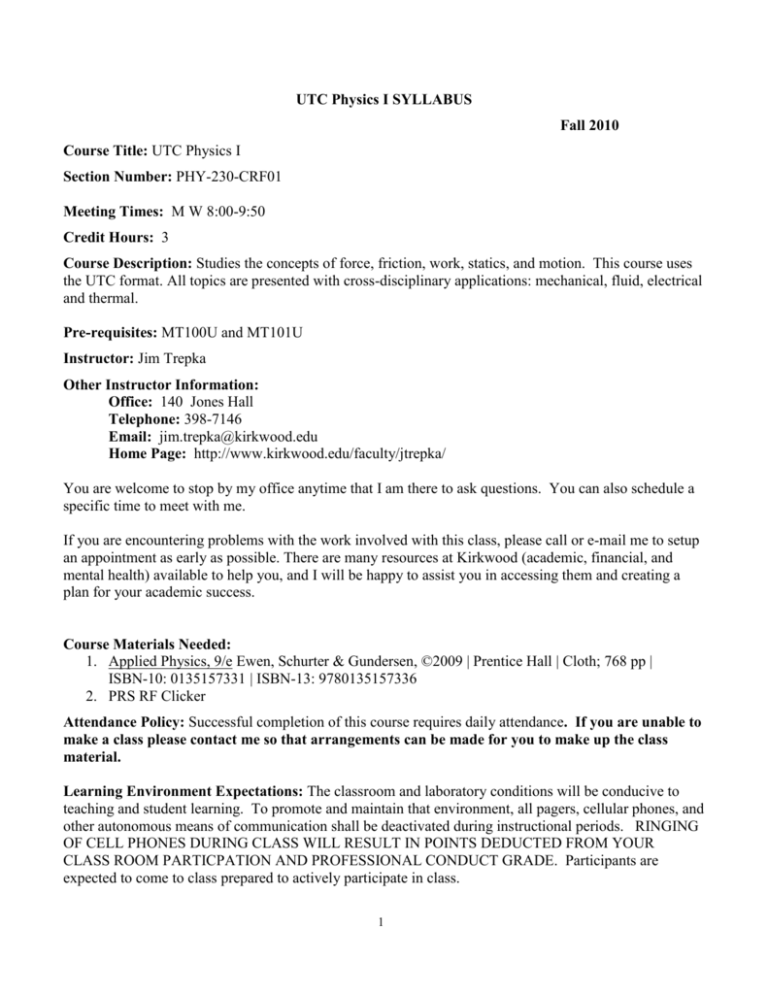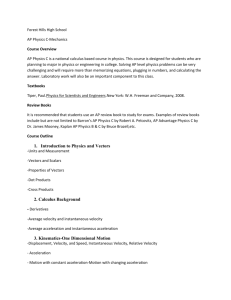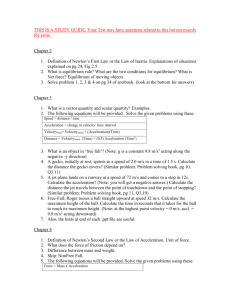Simple Machines Objectives
advertisement

UTC Physics I SYLLABUS Fall 2010 Course Title: UTC Physics I Section Number: PHY-230-CRF01 Meeting Times: M W 8:00-9:50 Credit Hours: 3 Course Description: Studies the concepts of force, friction, work, statics, and motion. This course uses the UTC format. All topics are presented with cross-disciplinary applications: mechanical, fluid, electrical and thermal. Pre-requisites: MT100U and MT101U Instructor: Jim Trepka Other Instructor Information: Office: 140 Jones Hall Telephone: 398-7146 Email: jim.trepka@kirkwood.edu Home Page: http://www.kirkwood.edu/faculty/jtrepka/ You are welcome to stop by my office anytime that I am there to ask questions. You can also schedule a specific time to meet with me. If you are encountering problems with the work involved with this class, please call or e-mail me to setup an appointment as early as possible. There are many resources at Kirkwood (academic, financial, and mental health) available to help you, and I will be happy to assist you in accessing them and creating a plan for your academic success. Course Materials Needed: 1. Applied Physics, 9/e Ewen, Schurter & Gundersen, ©2009 | Prentice Hall | Cloth; 768 pp | ISBN-10: 0135157331 | ISBN-13: 9780135157336 2. PRS RF Clicker Attendance Policy: Successful completion of this course requires daily attendance. If you are unable to make a class please contact me so that arrangements can be made for you to make up the class material. Learning Environment Expectations: The classroom and laboratory conditions will be conducive to teaching and student learning. To promote and maintain that environment, all pagers, cellular phones, and other autonomous means of communication shall be deactivated during instructional periods. RINGING OF CELL PHONES DURING CLASS WILL RESULT IN POINTS DEDUCTED FROM YOUR CLASS ROOM PARTICPATION AND PROFESSIONAL CONDUCT GRADE. Participants are expected to come to class prepared to actively participate in class. 1 Productive Classroom Learning Environment: We believe that the best learning takes place in an environment where faculty and students exhibit trust and mutual respect. Students promote trust by preparing honest and thoughtful work, and by expecting evaluation based on performance. Faculty promote trust by setting clear guidelines for assignments and evaluations, honest feedback, and by assigning bias-free grades. Students show respect by being prepared and attending class on time, by paying attention, contributing to discussions, listening respectfully to others’ points of view, meeting deadlines, and by striving for their best performance. Faculty show respect by their timeliness and preparedness, by taking students seriously, by valuing their goals and aspirations, and by providing honest feedback. In a productive learning environment, faculty and students work cooperatively, recognize and respect differences, model the values of character and citizenship, and become lifelong learners. Class Attendance Policy and College Sponsored Activities: Class Attendance Policy: Learning is central to our work at Kirkwood Community College. Faculty design educational experiences to facilitate learning, and students learn by engaging in those experiences. Attendance and engagement in all scheduled classes is regarded as integral to learning and is expected of all students. Kirkwood faculty members identify expectations for learning and attendance in their course syllabi. Students are accountable for the learning outcomes for each session, including those sessions that have been missed. Assessments of learning that occur during an absence may or may not be made up, depending on the policies of the instructor and the nature of the absence. Absences that result from participation in college sponsored activities* will be accommodated, subject to the guidelines listed below. For all other absences, authorization of an excuse is the province of the individual faculty member and subject to the standard appeal process. College Sponsored Activities: Students involved in activities where they are required to represent the college, i.e. collegesponsored activities, must give written notice to the faculty member at least one week in advance of the absence unless last minute schedule changes make this notice impossible. If regular season athletic schedules have been developed, student participants must present written notice of anticipated absences within the first week of the semester. Failure to provide timely written notice may result in loss of this opportunity. Faculty shall accord students the opportunity to independently make up course work or work of equal value, for the day(s) the event was scheduled and to take a scheduled exam at an alternate time. The faculty member shall determine alternate exam times and due dates for missed coursework. These assigned dates may be prior to the date of the absence. Organizers (coaches, faculty and staff) of college sponsored activities shall 1) assist students in planning class schedules to minimize the number of absences; 2) inform students of their responsibilities as described above; and 3) provide written communications to faculty announcing 2 and verifying the need for student class absences. Written notices should be provided at the beginning of the semester if the schedule is known, or as soon as possible after the need for a student absence is determined. * College sponsored activities (excluding practices) include such events as athletic competitions, student academic competitions and conferences, musical and drama performances, and class field trips. Questions on whether an activity is a college-sponsored event for purposes of this policy should be directed to the Vice-President of Instruction. If anticipated absences for a semester appear to be extraordinarily numerous or difficult to accommodate, a faculty member may appeal the need for the full accommodation to the VP of Instruction. Plagiarism Policy: According to Webster, to plagiarize is “to steal or pass off the ideas or words of another as one’s own…to use created productions without crediting the source…to commit literary theft…to present as new and original an idea or product derived from an existing source.” Kirkwood Students are responsible for authenticating any assignment submitted to an instructor. If asked, you must be able to produce proof that the assignment you submit is actually your own work. Therefore, we recommend that you engage in a verifiable working process on assignments. Keep copies of all drafts of your work, make photocopies of research materials, write summaries of research materials, hang onto Writing Center receipts, keep logs or journals of your work on assignments and papers, learn to save drafts or versions of assignments under individual file names on computer or diskette, etc. The inability to authenticate your work, should an instructor request it, is a sufficient ground for failing the assignment. In addition to requiring a student to authenticate his/her work, Kirkwood Community College instructors may employ various other means of ascertaining authenticity – such as engaging in Internet searches, creating quizzes based on student work, requiring students to explain their work and/or process orally, etc. Americans with Disabilities Act: Students with disabilities who need accommodations to achieve course objectives should file an accommodation application with Learning Services, Linn Hall 133 and provide a written plan of accommodation to your instructor prior to the accommodation being provided. Learning Outcomes, Objectives, and Course Competencies: 1. Differentiate between a scalar and a vector quantity. Calculate the components of a vector. Illustrate graphically and mathematically the resultant of two or more vectors. 2. Give a definition and measure velocity and acceleration, using proper units. Solve problems that involve velocity and uniform acceleration. 3. Using proper units, give a definition and measure mechanical force. State Newton’s Three Laws. Describe and predict what happens in a system when forces are balanced or unbalanced. Solve problems that involve Newton’s Three Laws. 3 4. Give a definition and measure friction in mechanical systems. Solve problems that involve static and kinetic friction including incline problems. 5. Give a definition and measure work, energy, and power in linear mechanical and electrical systems. Explain the relationship between energy and work. Explain the relationship between potential and kinetic energy. Explain the conservation of energy law. Solve electrical and mechanical problems that involve work, energy, and power. 6. Calculate the mechanical advantages of force transformers in mechanical and fluid systems. Solve problems that involve mechanical advantage in simple machines such as a lever, an inclined plane, a wedge, gears, pulley systems, wheel and axle, screw jack, and belt drive. Construct simple machines and analyze their behavior. Differentiate between ideal mechanical advantage and actual mechanical advantage. Calculate efficiency of a simple machine based on mechanical advantage (actual/ideal) and based on work (output/input). 7. State the equation for an impulse and momentum and explain the terms. Express the law of the conservation of linear momentum mathematically and give examples. Describe a perfectly elastic collision algebraically and conceptually. Solve problems with impulse and momentum. Measure impulse and momentum experimentally. 8. Describe static equilibrium. State mathematically and conceptually the first condition of equilibrium. Create a free body diagram and use the diagram to solve for unknown forces or force components. Illustrate by example and definition your understanding of the term torque. Solve complex problems involving torque. Balance different masses in a system by establishing equal torques. 9. Define mathematically and conceptually angular displacements, angular velocity, and angular acceleration. Apply these concepts to the solution of complex problems. Measure the angular velocity and acceleration of a system. 10. Give a definition and measure work and energy involving rotational inertia. Define angular momentum. Contrast and compare linear system to rotational systems. Solve inertial problems. 11. Actively participate in class laboratories. Assume responsibility for laboratory equipment. Assist other students and contribute to group activities. Conform to all stated safety standards. Use appropriate language in and out of the classroom. UTC Physics I Textbook Competencies (The wording for these competencies is from PHYSICS, Sixth Edition by Paul E. Tippens) Vectors Objectives 1. Define a vector quantity and a scalar quantity and give examples of each. 2. Determine the components of a given vector. 3. Find the resultant of two or more vectors. 4 Motion Objectives 1. Define and apply definitions for average velocity and average acceleration. 2. Solve problems involving time, displacement, average velocity, and average acceleration. 3. Apply one of the five general equations for uniform acceleration to solve for one of the five parameters: initial velocity, final velocity, acceleration, time, and displacement. 4. Solve general problems involving free-falling bodies in a gravitational field. 5. Explain with equations and diagrams the horizontal and vertical motion of a projectile launched at various angles. 6. Determine the position and velocity of a projectile when its initial velocity and position are given. 7. Determine the range, the maximum height, and the time of flight for projectiles when the initial velocity and angle of projection are given. Newton’s Law Objectives 1. Describe the relationships among force, mass, and acceleration and give the consistent units for each in the metric and U.S. customary system of units. 2. Demonstrate by example or experiment your understanding of Newton’s first and third laws of motion. 3. Define the units Newton and slug and explain why they are derived units rather than fundamental units. 4. Demonstrate by definition and example your understanding of the distinction between mass and weight. 5. Determine mass from weight and weight from mass at a point at which the acceleration due to gravity is known. Friction Objectives 1. Solve for unknown forces by applying the first condition for equilibrium. 2. Apply your understanding of kinetic and static friction to the solution of equilibrium problems. Work, Energy, and Power Objectives 1. Define and write mathematical formulas for work, potential energy, kinetic energy, and power. 2. Apply the concepts of work, energy, and power to the solution of problems similar to those given as examples in the text. 3. Define and demonstrate by example your understanding of the following units: joule, foot-pound, watt, horsepower, and foot-pound per second. 4. Discuss and apply your knowledge of the relationship between the performance of work and the corresponding change in kinetic energy. 5. Discuss and apply your knowledge of the principle of conservation of mechanical energy. 6. Determine the power of a system and understand its relationship to time, force, distance, and velocity. Simple Machines Objectives 1. Describe a simple machine and its operation in general terms to the extent that efficiency and conservation of energy are explained. 2. Write and apply formulas for computing the efficiency of a simple machine in terms of work or power. 5 3. Distinguish by definition and example between ideal mechanical advantage and actual mechanical advantage. 4. Draw a diagram of each of the following simple machines and beside each diagram write a formula for computing the ideal mechanical advantage: (a)lever, (b) inclined plane, (c) wedge, (d) gears, (e) pulley systems, (f) wheel and axle, (g) screw jack, (h) belt drive. 5. Compute the mechanical advantage and the efficiency of each of the simple machines listed in the previous objective. Impulse and Momentum Objectives 1. Define and give examples of impulse and momentum as vector quantities. 2. Write and apply a relationship between impulse and the resulting change in momentum. 3. State the law of conservation of momentum and apply it to the solution of physical problems. 4. Distinguish by example and definition between elastic and inelastic collisions. 5. Predict the velocities of two colliding bodies after impact when the masses and initial velocities are given. Statics Objectives 1. State the first condition for equilibrium, give a physical example, and demonstrate graphically that the first condition is satisfied. 2. Construct a free-body diagram representing all forces acting on an object that is in translational equilibrium. 3. Draw a free-body diagram for objectives in motion with constant acceleration, set the resultant force equal to the total mass times the acceleration, and solve for unknown parameters. Rotation of Rigid Bodies Objectives 1. Define angular displacements, angular velocity, and angular acceleration, and apply these concepts to the solution of physical problems. 2. Draw analogies relating rotational-motion parameters (θ, ω, α)to linear-motion parameters, and solve angular acceleration problems in a manner similar to that learned for linear acceleration problems. 3. Write and apply the relationships between linear speed or acceleration and angular speed or acceleration. 4. Define the moment of inertia of a body and describe how this quantity and the angular speed can be used to calculate rotational kinetic energy. 5. Apply the concepts of Newton’s second law, rotational work, rotational power, and angular momentum to the solution of physical problems. Dynamics of Rotation Objectives 1. Illustrate by example and definition your understanding of the terms moment arm and torque. 2. Calculate the resultant torque about any axis when given the magnitude and position of forces on an extended object. 3. Solve for unknown forces or distances by applying the first and second conditions for equilibrium. 4. Define and illustrate by example what is meant by the center of gravity. 6 Assessment of Student Learning: Student learning will be assessed via exams, homework, class room participation, and lab reports. Student Evaluation: Final Exam – A comprehensive final exam totaling 20% of your final grade will be administered during finals week. Unit Exams - Exams will be given after every 3 or 4 chapters totaling 40% of your final grade. Missed exams must be made up on or before the next class period. In a rare situation where the exam can not be made up in that time period, the student will need to make up the exam during the final exam week and this exam will be different than that taken by the rest of the class. All exams will be cumulative. Labs - Labs will be worth 30% of your final grade. Labs will be done in groups of up to four people. You will lose a point per minute late if you are late to a lab. THERE WILL BE NO MAKE UP LABS!!! Class Room Participation and Professional Conduct - 10% of your final grade Points will be added to classroom participation and professional conduct grade based on the following: 1. 2. 3. 4. Arrival at class by 8 am (50 % of class participation grade) Performing in class problems Helping lab partner or other lab groups. Helping other classmates. Points will be deducted from the classroom participation and professional conduct grade for the following: 1. Inappropriate language or jokes. 2. Ringing of cell phones in class. 3. Disrupting the class. 4. Leaving class early or not arriving back to class by 9:00, after the 8:00 break. 5. Not cleaning up workspace at the end of the class. Grading Scale: A letter grade will be computed using the following grading scale. A = B+ = C+ = D+ = F = 94 - 100 87 – 89.99 77 – 79.99 67 - 69.99 00.0 - 59.9 A- = 90 – 93.99 B = 83 – 86.99 C = 73 – 76.99 D = 63 – 66.99 FW = Failure to withdraw B- = 80 – 82.99 C- = 70 – 72.99 D- = 60 – 62.99 FW has the same negative affect on your grade point as a F. The FW grade indicates a student failed the course, had not attended after the 60% point of the course, and did not withdraw by the withdraw deadline. That letter grade will then be adjusted according to the attendance policy to compute the final grade for the course. Late Policy: No late work will be accepted! 7 Make up Policy: THERE WILL BE NO MAKE UP LABS!!! Missed exams must be made up on or before the next class period. In a rare situation where the exam can not be made up in that time period, the student will need to make up the exam during the final exam week and this exam will be different than that taken by the rest of the class. Drop Date: Students dropping a class during the first two weeks of a term may receive a full or partial tuition refund. Details of the refund schedule are available from Enrollment Services in 216 Kirkwood Hall. For detailed discussion of drop dates and policies, please read the student handbook. The last day to drop this course is November 16. The tentative date for the final in this class is Monday December 13 at 8 am. 8





